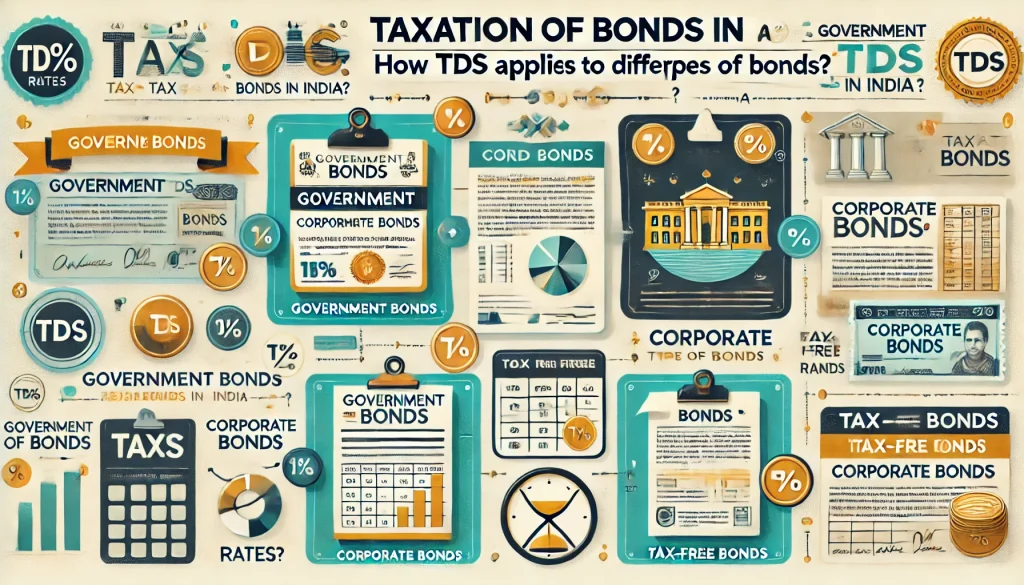
Tax-free bonds issued by the government aim to collect funds for government activities. The government offers interests to the investors payable semi-annually or annually. Thus, if you invest in this type of bond, you can earn an income twice or once a year. Learn about this type of bond here in detail to make informed decisions.
What Are Tax-Free Bonds?
Government entities issue tax-free bonds to raise funds for development and growth activities. These bonds are low-risk investments as they offer a fixed interest rate. The interest income from these bonds is tax-free under Section 10 of the Income Tax Act, 1961.
Usually, the investment tenure of these bonds is 10 years more. The government raises funds from these bonds to invest in infrastructure and housing projects. An example of a tax-free bond is municipal bonds that municipal corporations issue.
Features and Benefits of Tax-free Bonds
The following are the features and benefits of a tax-free bond:
Features
Here are the features of a tax-free bond:
- Tax Exemption: The interest income from tax-free bonds is exempted from taxation under Section 10 of the Income Tax Act.
- Fixed Interest Rates: The interest rates of these bonds are predetermined and remain unchanged throughout the entire tenure of investment.
- Government Support: As the government issues these bonds, they are highly secure. Conservative investors can thus consider investing in these bonds.
- Long Tenure: These bonds have a long maturity tenure. This tenure ranges between 10 years to 20 years usually.
- Liquidity: Even though these bonds are not completely liquid, you can trade these bonds on stock exchanges.
- Low Interest Rates: Tax-free bonds offer a relatively lower interest rate to investors than other fixed-income instruments. This is due to the tax exemption on interest of these bonds.
Benefits
The following are the benefits of a tax-free bond:
- You can earn tax-free interest from your investment in these bonds.
- These bonds are low-risk due to government association.
- As the interest rates are predetermined, you can earn predictable and stable income from a tax-free bond.
- These bonds are listed in the Indian stock exchanges, ensuring opportunities for trading.
How Do Tax-Free Bonds Work?
When an investor invests in a tax-free bond, he/she lends money to a government-backed issuing authority. As a result, the government pays interest to the investors annually. However, this interest is tax-free for investors.
The government returns the principal amount to the investor at the end of the bond tenure. This tenure usually ranges between 10 to 20 years. These bonds are also listed on stock exchanges which enables investors to sell them before the maturity tenure.
How to Invest in Tax-Free Bonds?
Here are the steps to invest in a tax-free bond:
Step 1: Open a demat (dematerialised) account with a depository participant of your choice (if you do not have one already).
Step 2: Select a tax-free bond that you want to invest in.
Step 3: Check if you are eligible to invest in the bond. Usually, resident individuals, Hindu Undivided Families (HUFs) and non-resident Indians (NRIs) are eligible to invest in these bonds.
Step 4: Apply for the bond that suits your financial goals. Usually, different issuers offer variable interest rates and maturity tenure.
Step 5: Transfer funds from your bank savings account to your demat account.
Step 6: The issuer will send you a physical bond certificate or a confirmation email.
Step 7: You can track your bond in your demat-trading account.
Notably, you will receive interest payouts annually or semi-annually based on the terms and conditions of the bond.
List of Common Types of Tax-free Bonds in India
Here are the common types of tax-free bonds in India:
- Infrastructure Bonds: Infrastructure companies issue these bonds to raise funds for projects such as roads, airports and power plants.
- Housing Bonds: The National Housing Bank often issues this bond to collect funds for affordable housing projects.
- Power Bonds: Power generation companies often issue these bonds to expand and maintain power plants.
- Railway Bonds: The Indian Railways issues this bond to fund railway network modernisation and expansion.
- Public Sector Unit Bonds: Government-owned companies issue this bond to finance housing, power and infrastructure projects.
Who Should Invest in Tax-Free Bonds?
Risk-averse investors can invest in a tax-free bond. As the government issues these bonds, the risks associated are minimal. In addition, if you want to invest for a longer investment horizon with long-term financial goals, you can consider investing in a tax-free bond. Ensure you consider the liquidity of such a bond before investing.
Issuing Authority of Tax-free Bonds
The following are the issuing authorities of tax-free bonds:
- National Highways Authority of India (NHAI)
- Power Finance Corporation (PFC)
- Indian Railways Finance Corporation (IRFC)
- Rural Electrification Corporation (REC)
Differences Between Tax-free Bonds and Tax-saving Fixed Deposits
Here are the differences between a tax-free bond and a tax-saving fixed deposit:
| Features | Tax-free Bonds | Tax-saving Fixed Deposits |
| Interest Rate | Lower than other fixed-income instruments, around 5-6% | Higher than tax-free bonds, around 6-8% |
| Tax Benefit | Interest income is tax-free | You can avail tax deductions under Section 80C on the principal amount |
| Lock-in Period | 10 to 20 years | 5 years |
| Liquidity | Tradable on stock exchanges | You cannot withdraw it before maturity (5 years) |
| Risk | Low risk | Low to moderate risk |
| Investment Limit | No upper limit | Up to ₹1.5 lakh in a financial year |
| Suitable For | Investors with long-term financial goals | Investors looking for a return after 5 years |
The Bottom LineTax-free bonds usually have a time horizon of 10 to 20 years. Investors with long-term financial goals can choose to invest in such a bond. The interest income credited semi-annually or annually by the issuing authority is tax-free under Section 10 of the Income Tax Act. If you want a tax-free return, invest in this type of bond using your demat-trading account.
RBI bond is not a tax-free bond; rather it is a taxable bond. The interest income on RBI bonds is subject to taxation wherein TDS is deducted.
The interest earned on 5-year tax-free bonds are exempted from income tax under Section 10 (15) of the Income Tax Act, 1961. As a result, investors can reap the benefits of tax-free income.
Retail investors can invest up to ₹5 lakh in tax-free bonds.


